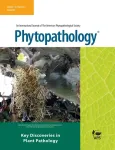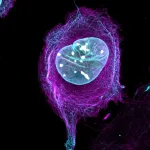(Press-News.org) In just 7 years, the Irish Potato Famine caused approximately one million people to starve to death and forced another estimated million to flee Ireland as refugees. A mold called Phytophthora infestans infected Ireland’s potato crop, a staple food, and spread rapidly throughout the island. The seemingly tiny fungus destroyed roughly 75% of potato crops over the duration of the great hunger. This catastrophic famine, along with several others in various parts of the world throughout history, highlighted the critical need for the study of plant diseases.
Decades of groundbreaking discoveries about plant diseases ensued in the following century. Building from these discoveries, plant pathology continues to play a vital role in safeguarding plant health, food security, and food safety worldwide. The flagship journal of the American Phytopathological Society, Phytopathology, recently published a special issue—the first of a new series—examining how several key discoveries in plant pathology during the past 50 years have impacted the life sciences and plant disease management. This issue contains articles by top experts in various scientific fields, who review the discovery process, recent progress, and impact of these discoveries, while pointing out future directions for new discoveries in fundamental and applied plant pathology.
The key discoveries discussed in the first installment of this journal series include the Agrobacterium Ti plasmid and its mechanism in T-DNA transfer; bacterial ice nucleation; cloning of resistance genes; discovery of viroids; effectors and their mechanisms; pattern-triggered immunity and effector-triggered immunity; RNA interference and gene silencing; structure and function of R genes; transcription activator-like effectors; type-III secretion system and hrp/hrc; the deployment and management of host resistance genes; the application of disease models and forecasting systems; the introduction of modern systemic fungicides and host resistance inducers, along with a better understanding of fungicide resistance mechanisms and management; and the utilization of biological controls and suppressive soils, including the implementation of methyl-bromide alternatives.
These articles, both retrospective and forward-thinking, can significantly benefit researchers and students in plant pathology (plus related fields) and applied plant disease managers. Additionally, the Key Discoveries in Plant Pathology series will continue to benefit these individuals as new issues addressing other topics are published. Phytopathology Editor-in-Chief Nian Wang and past Editor-in-Chief Harald Scherm remark, “The special issue includes many key discoveries in plant pathology with tremendous importance. To allow coverage of important discoveries that were not reviewed due to space and time limitations in the present issue, the Key Discoveries series will continue as special issues or as individual articles. Colleagues are encouraged to submit review articles on key discoveries in plant pathology in the past 50 years.” In addition, the journal series will feature articles on the impact of advances in fields such as climate science, remote sensing, artificial intelligence, imaging technology, and synthetic biology on the discipline of plant pathology.
The aim of this issue and further issues is to explore how plant pathology has helped, and continues to help, protect plant and environmental health in the face of population growth and climate change.
For additional information, read “Key Discoveries in Plant Pathology”—Vol. 113, No. 4 / April 2023 of Phytopathology.
Follow us on Twitter @PhytopathologyJ and visit https://apsjournals.apsnet.org/journal/phyto to learn more.
END
Leading plant science journal publishes a special issue on key discoveries in plant pathology
2023-06-07
ELSE PRESS RELEASES FROM THIS DATE:
Autonomous products like robot vacuums make our lives easier. But do they deprive us of meaningful experiences?
2023-06-07
Researchers from University of St. Gallen and Columbia Business School published a new Journal of Marketing article that examines how the perceived meaning of manual labor can help predict the adoption of autonomous products.
The study, forthcoming in the Journal of Marketing, is titled “Meaning of Manual Labor Impedes Consumer Adoption of Autonomous Products” and is authored by Emanuel de Bellis, Gita Venkataramani Johar, and Nicola Poletti.
Whether it is cleaning homes or mowing lawns, consumers increasingly delegate manual tasks to autonomous products. These gadgets operate without human oversight and free consumers from ...
Paul Ellison, PhD, receives SNMMI Mars Shot Fund award
2023-06-07
Reston, Virginia—The SNMMI Mars Shot Research Fund is excited to announce that Paul Ellison, PhD, assistant professor at the Department of Medical Physics at the University of Wisconsin School of Medicine and Public Health in Madison, has been selected as the recipient of a $500,000 grant from the 2023 Mars Shot Fund. The grants recognize individuals who have made transformative impact in the field and elevated the value of nuclear medicine and molecular imaging.
The grant is one of five awarded in the inaugural year of the new SNMMI Mars Shot Research Fund, which ...
Amir Iravani, MD, receives SNMMI Mars Shot Fund award
2023-06-07
Reston, Virginia—The SNMMI Mars Shot Research Fund is excited to announce that Amir Iravani, MD, associate professor of radiology in the Department of Radiology at the University of Washington School of Medicine in Seattle, Washington, has been selected as the recipient of a $1,000,000 SNMMI Mars Shot Fund Grant. The grants recognize individuals who have made transformative impact in the field and elevated the value of nuclear medicine and molecular imaging.
The grant is one of five awarded in the inaugural year of the new SNMMI Mars Shot Research Fund, which was established to provide resources that translate visionary nuclear medicine imaging, radiopharmaceutical therapy ...
Craig Levin, PhD, receives SNMMI Mars Shot Fund award
2023-06-07
Reston, Virginia—The SNMMI Mars Shot Research Fund is excited to announce that Craig Levin, PhD, professor of radiology, physics, electrical engineering and bioengineering at Stanford University in Stanford, California, has been selected as the recipient of a $500,000 grant from the 2023 Mars Shot Fund. The grants recognize individuals who have made transformative impact in the field and elevated the value of nuclear medicine and molecular imaging.
The grant is one of five awarded in the inaugural year of the new SNMMI Mars Shot Research Fund, which was established to provide ...
Julie Sutcliffe, PhD, receives SNMMI Mars Shot Fund award
2023-06-07
Reston, Virginia—The SNMMI Mars Shot Research Fund is excited to announce that Julie Sutcliffe, PhD, professor of internal medicine and biomedical engineering, University of California–Davis, has been selected as the recipient of a $500,000 grant from the 2023 Mars Shot Fund. The grants recognize individuals who have made transformative impact in the field and elevated the value of nuclear medicine and molecular imaging.
The grant is one of five awarded in the inaugural year of the new SNMMI Mars Shot Research Fund, which was established to provide ...
Randy Yeh, MD, receives SNMMI Mars Shot Fund award
2023-06-07
Reston, Virginia—The SNMMI Mars Shot Research Fund is excited to announce that Randy Yeh, MD, a radiologist and nuclear medicine physician at Memorial Sloan Kettering Cancer Center and assistant professor of radiology at Weill Cornell Medical College in New York, has been selected as the recipient of a $500,000 grant from the 2023 Mars Shot Fund. The grants recognize individuals who have made transformative impact in the field and elevated the value of nuclear medicine and molecular imaging.
The grant is one of five awarded in the inaugural year of the new SNMMI Mars Shot Research Fund, which ...
Investigating the placenta: Discovery from Stowers Scientists shows why this often-overlooked organ should be given more attention
2023-06-07
KANSAS CITY, MO—June 7, 2023—The placenta, critical for healthy embryo development, is a multi- purpose organ with a precise lifespan—the length of a pregnancy. New research from the Stowers Institute for Medical Research suggests that further exploration of the placenta’s roles and capabilities may one day lead to insights for positive pregnancy outcomes.
The study published in Development on June 6, 2023, focuses on a unique property of many cells comprising the placenta that explains how these cells perform essential functional and physical ...
Remnants of ancient virus may fuel ALS in people
2023-06-07
More than 5,000 people are diagnosed annually with ALS (amyotrophic lateral sclerosis), a fatal, neurodegenerative disease that attacks nerve cells in the brain and spinal cord, gradually robbing people of the ability to speak, move, eat and breathe.
To date, only a handful of drugs exist to moderately slow its progression. There is no cure.
But CU Boulder researchers have identified a surprising new player in the disease—an ancient, virus-like protein best known, paradoxically, for its essential role in enabling placental development.
The findings ...
Lack of timely follow-up after heart failure hospitalization for most adults with diabetes
2023-06-07
Research Highlights:
58% of adults with Type 2 diabetes covered by Alabama Medicaid did not receive prompt outpatient care after hospitalization for heart failure.
African American and Hispanic adults with Type 2 diabetes were less likely to have post-discharge follow-up health visits, or if they did, the visits occurred nearly two to three days later compared to white adults.
Embargoed until 4 a.m. CT/5 a.m. ET Wednesday, June 7, 2023
DALLAS, June 7, 2023 — More than half of Medicaid-covered adults in Alabama with Type 2 diabetes did not receive follow-up health care within the recommended two-week period following hospitalization for newly-diagnosed heart ...
Researchers discover chemical evidence for pair-instability supernova from a very massive first star
2023-06-07
The first stars illuminated the Universe during the Cosmic Dawn and put an end to the cosmic "dark ages" that followed the Big Bang. However, the distribution of their mass is one of the great unsolved mysteries of the cosmos.
Numerical simulations of the formation of the first stars estimate that the mass of the first stars reached up to several hundred solar masses. Among them, the first stars with masses between 140 and 260 solar masses ended up as pair-instability supernovae (PISNe). PISNe are quite different from ordinary supernovae (i.e., Type II ...







